I'm in an industrial kitchen at the back of Bunratty Castle and Folk Park in Co Clare, staring into the biggest cooking pot I've ever seen in in my life. You could easily drop a full sheep into it, hooves, head and all, stick on the lid, and come back a couple of days later to see what had happened in the meantime.
"Ninety kilos of ribs can go in here," chef Alan Burns tells me. He is 18 months into the job and the chef currently responsible for catering the Bunratty Banquets, which are run by Shannon Heritage. They have been going since 1963, serving a staggering cumulative figure of 2.8 million people since then. Sixty kilos of spare ribs are served at each banquet, and in this giant pot, they take 2½ hours to braise. Spare ribs have been on the menu right from the beginning, as has soup. It used to be potato and leek. These days, it is spiced parsnip, 30 litres per banquet.
"The food is secondary," declares general manager Ivan Tuohy, who's in the kitchen with us. "It's all about the entertainment. But we send people home with their bellies full. And we've never had a food poisoning outbreak, thank God."
It can’t be easy for Burns, who has previously worked as a pastry chef in a Michelin-starred restaurant (the now closed Longridge in Preston), and had his own restaurant (The Wild Bergamot outside Glasgow), to hear that even the general manager admits the food isn’t as important as the entertainment.
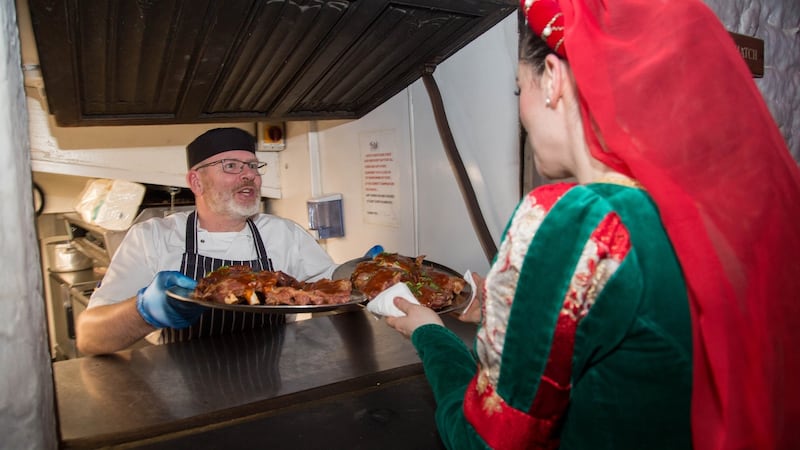
When Tuohy is out of earshot, Burns says wistfully, "I was told when I got this job that the menu had to remain static. But it's a medieval banquet: I'd love to do whole pigs on a spit, poussin chicken you tear apart with your hands; things like that, but it's not practical." Burns did, however, manage to create a new sauce for the ribs, Bunratty Kitchen Barbecue Sauce, which recently won a Taste of Ireland award.
The Bunratty banquet operates year-round, with two sittings as demand requires, at 5.30pm and 8.45pm. The Banqueting Hall in the castle can hold 141 people per sitting. The price of attendance when it began was 35 shillings, the equivalent of about €2 today; the cost of a ticket now is €58.45.
Like the presence of spare ribs on the menu since time immemorial, the format of the evening is essentially unchanged since 1963. Guests are greeted on the drawbridge of the castle, they go upstairs to the Great Hall to have a goblet of mead and hear a spiel about the building, head down to the Banquet Hall for their ribs and are served and entertained throughout by a butler and a number of singers, all wearing medieval costumes.
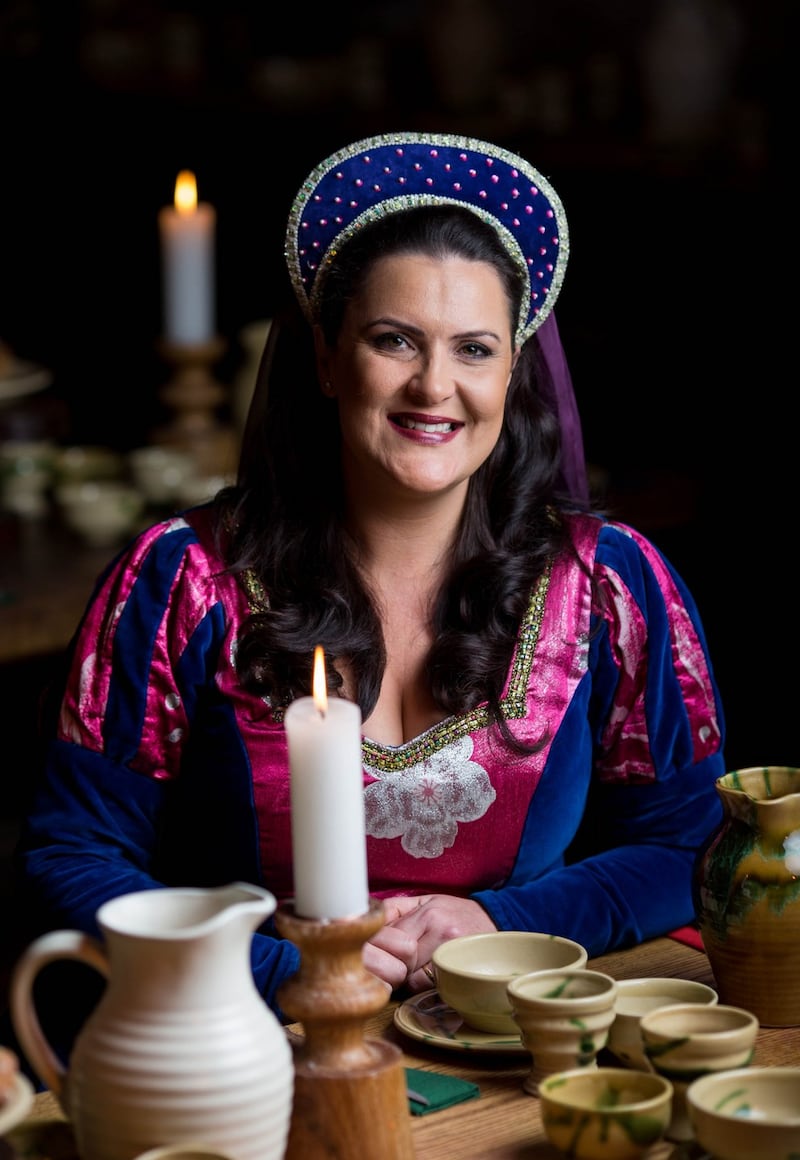
Lynn Connolly is one of the singers, and has been working at Bunratty for 22 years. She has heard it all, when it comes to what the guests have to say.
“Why is the castle built so close to the highway?”
“Do you get paid for this, or do you volunteer?”
“Are you all related to each other?”
“Some of them think that myself and the other singers are sisters and brothers, and that the butler is our father,” Connolly says, rolling her eyes. Her current costume is with her, ready for when she goes upstairs to change. It’s a long dark-blue velvet dress, with gold braid, in a medieval style. There’s a jewelled velvet headband too.
They get one costume at a time, for which it is the responsibility of each performer to maintain. Connolly has been through, she thinks, about 20 costumes since she started working here. “Half the girls upstairs are wearing my old costumes.” They mightn’t be related to each other, but like family, her Bunratty sisters inherit the hand-me-downs.
Connolly says you have to be “a certain type of person to work here. You have to be happy in yourself, and you have to love performing.” You also have to be an exceptional singer to be hired: the Bunratty singers over the years have always been highly talented. The entertainers, in addition to singing at intervals throughout the banquet, and giving short narratives, also serve a table each, while staying in character. “What you get is our personality,” as Connolly puts it. “You don’t get an act. We’re ourselves.”
They sing a mixture of madrigals, ballads, folk songs and lullabies – everything from Greensleeves to Danny Boy and Dúlamán. "The biggest challenge is that it's a challenge in itself to be doing something so repetitive. It could be your 14th banquet in a row, and you're smiling and still performing. You're thinking, I'm dead on the inside, but I'll sing Danny Boy for you," she says. "Oh my God, don't put that in," she jokes, as I write it down.
At the banquets Connolly worked at in her earlier years, the entertainers were required to put bibs on the guests. Now there are piles of paper napkins on the tables, to deal with the barbecue sauce. “We used to serve snuff at the end of the meal too. In the end, the snuff had to go, because of health and safety: everyone used to be sneezing their heads off.”
At 4.30pm, the castle shuts to visitors, while the staff set up for the first banquet of the day. I go in to have a look before everyone arrives. The Banquet Hall is a beautiful space, with its vast ceiling, whitewashed stone walls, narrow mullioned windows and long, simple oak tables. There is a working fireplace, but it doesn’t get lit. Each place-setting gets a pottery goblet, small bowl, plate, fingerbowl and a knife, but no other cutlery; you’re meant to eat with your hands. There are jugs of wine and water, and roughly-carved wooden candleholders for large candles, the diameter of a wrist.
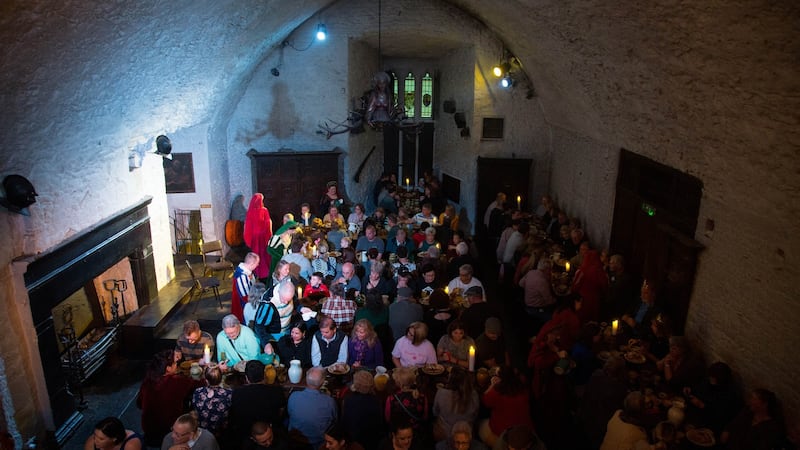
The snuff may not have survived health and safety, but thankfully, the dungeon endures. Like the eternal appearance of ribs at the banquet, the tradition of selecting a villain – always a man – to be temporarily dispatched to the dungeon still survives. Tuohy opens the metal grille at its entrance, and we go down a flight of narrow, winding stone stairs. The stairs stop at another grille, and I peer down into a long drop, with gloomy lighting. There’s something down there.
“Is that a rat?” I ask.
Tuohy starts. “A rat?” He looks down into the dungeon, er, rattled.
It is just the kind of dank lodging a rodent would favour, particularly in the proximity to the nightly consumption of so many bacon ribs. But the object I have spied at the bottom of the dim dungeon is not a giant rat: it is some indeterminate stuffed object, with a wig. “Ah, that’s the prisoner,” says Tuohy.
Tom Meaney is one of three butlers, who take turns in the role. He's currently the longest-serving butler, with 14 year' experience under his magnificent purple velvet doublet. It's the butler's job to select the villains for the dungeon each evening. I ask why it is always a man.
“It’s because of the line in the script,” he says. “The person is accused of not being a true gentleman, because he has been ‘trifling with the ladies of the castle’. Although these days,” he adds, “you wouldn’t know who is trifling with who.”
The role of the butler is akin to a maître’d for the night, albeit one in tights. “Our costumes are in the style of Henry the Eighth,” Meaney says. “We get a lot of comments on our tights from the guests. I feel a hand on my leg from time to time, from people – men and women – who say they are checking my seams. We are often admired for our legs.”
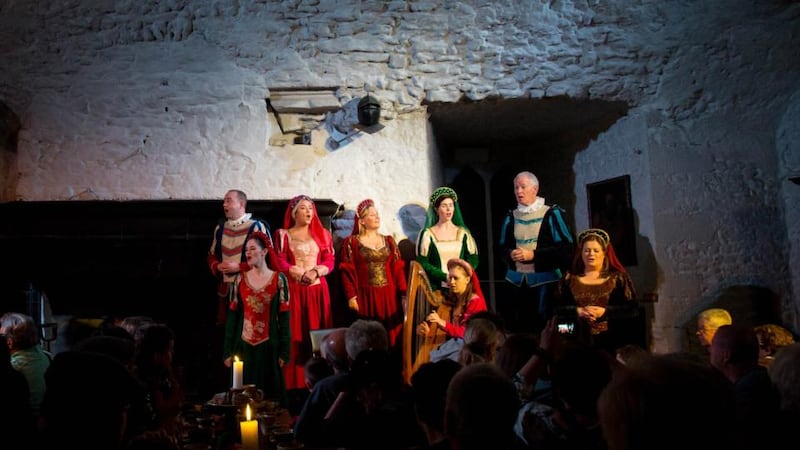
It’s showtime. It’s a full house tonight, and the guests are arriving, chiefly Americans, from what I can glean from the accents. They head up to the Great Hall first, for their goblet of mead. The Great Hall is a genuinely impressive space; with cavernous ceilings, huge tapestries, and several sets of antlers. Some are elk, and some are moose, who perhaps swam across the Atlantic at some point to get here, as moose is not a creature native to either Co Clare or Ireland.
In the Great Hall, I mingle with some of the guests. "This banquet has been going since 1963," I say to one woman from New Jersey, who is here as part of a CIE tour.
“Honey, did you hear that,” my new friend says to her husband, tapping him on the shoulder. “This woman has been working here since 1963, when the banquets started.”
I don’t know what I am more appalled at: the thought that I look as if I am at least 70 years’ old, or the fact that my new friend’s mental arithmetic is so astonishingly bad. I am not usually vain, but I cannot let this aberration go. I explain that while the banquet itself has been going since 1963, that I personally was not alive then, and thus I am not a living link to the past. They both look sorely disappointed.
It’s during the mead-drinking that an Earl and his Lady are chosen; which means they get the best seats in the house, and to play along with choosing the villain. They also each get to wear rather lovely metal crowns studded with glass stones, made by a blacksmith. (I had been told earlier that a famous Irish singer – name known to this reporter – recently absconded with the crown she was given to wear for the night. “We thought she was going out for a cigarette and she never came back,” Meaney relates. “She went off with our crown. The cheek of her.”)
It’s time to head downstairs. I descend the narrow stone stairs behind a vocal American man. “Can you imagine climbing these frigging stairs every frigging day?” he says rhetorically.
Downstairs in the Banquet Hall, the candles have been lit, and the room looks properly atmospheric. With the flickering candlelight, and the long tables and the pottery place settings, the space really does have the authentic feeling of a medieval refectory. Much as Shannon Heritage would love to put more posteriors on the padded benches every night, they can’t increase the numbers, as it’s impossible to extend the space. So it really is true to say, as Shannon Heritage does, that the families of those who come to the banquets now are having more or less exactly the same experience as their parents or grandparents.
And we’re off. The singers, tonight numbering six Ladies and three Gentleman of the castle, help direct people to their tables. Resplendent in her long velvet gown, Connolly comes by my table to make sure everything is okay. “Everything all right, my lady?” she says brightly, in character, and I giggle into my spiced parsnip soup.
Alica Furey from California is sitting beside me. She's here with her husband, Paul, and a friend of their's, Christina Ruffin. She's missing her knife from the place setting. A Lady comes by with another. "If we were under siege and you had no knife to protect yourself with, I would be to blame," the Lady says, slick as anything.
My dining companions slowly realise there are no further items of cutlery arriving. It's a knife, and that's it. They pick up the little soup bowls, glance up and down the table at everyone else, and eventually start drinking straight from the bowl. We're hardly done with our soup, when the singers start into When Irish Eyes Are Smiling. Everyone in the room is swaying from side to side, like sheaves of barley on our padded benches.
“This would be a great place for a first date,” Alica Furey says.
“Yes,” Ruffin agrees. “You’d see if the person was any fun or not.”
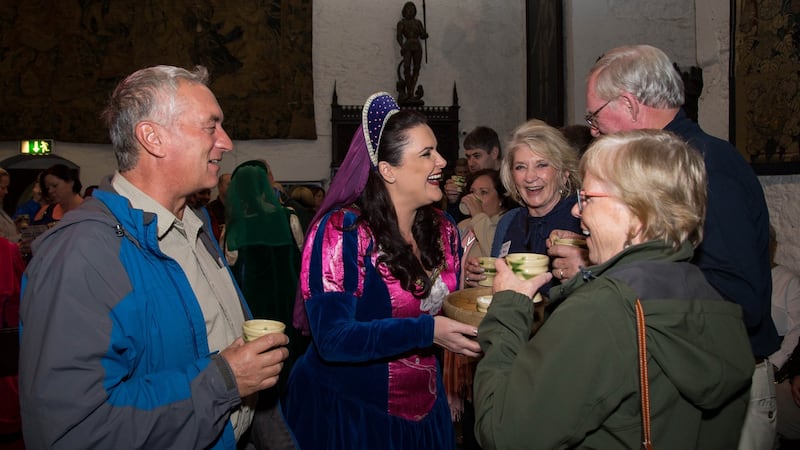
Alison Button and her boyfriend, Sidney McCrimmon, also from California, are on my other side. When the ribs arrive, huge communal plates of them, dripping with Burns's barbecue sauce, they sit with their hands in their laps for a while. I dig in, and after a while, they gingerly pick up their own ribs. 'This is our second castle," Button tells me. "We were in Blarney earlier in the week. Those stairs are so narrow; I got a bit claustrophobic."
The evening is part panto, part theatre, part medieval-themed cabaret. The singing, which happens frequently, is excellent: sweet, heartfelt, mournful and charming by turns. It might feature the most Oirish numbers in the canon of Irish ballads, but at least the songs, accompanied by harp and fiddle, are executed beautifully. The entertainers may have sung these songs more times that they ever want to know, but nobody looks or sounds dead on the inside. Meaney, as the Butler, is brilliant: a total pro, expertly playing the crowd, keeping the energy levels up, seamlessly moving things along, whether it is the introduction of the next course, narration, song – or the selection of the night’s villain.
Ah, the villain, who always has to be a man. “A youngish man,” as Meaney has already told me. “Who can deal with the stairs. You have to pick someone who’s willing to go with it.” He has already been to our table, joshing with Sidney McCrimmon, who has no idea what is ahead. I fear my presence at the table has something to do with Meaney’s close attention to my fellow guests.
But when the time comes for the villain to be selected, it’s not McCrimmon. The man denounced for trifling with the ladies is an Irishman, a man called Éamon, a couple of tables away from me.
"To the dungeon!" howls Meaney with glee, as he encourages everyone to make as much noise as possible, by stamping our feet, banging on those old oak tables with our fists, and hissing at Éamon, the lady-trifling villain. It's the key panto scene of the evening. Éamon is duly dispatched to the dungeon, from which quite convincing roars of agony are soon heard. When he eventually reappears, he is made to sing something before being allowed to sit down again, and surprises us all (well, me anyway) with a lovely rendition of Spancil Hill.
The food, as general manager Ivan Tuohy has already admitted, is indeed secondary to the evening’s entertainment. There is only so much you can do when catering for 280 or so people a night – night after night.
I ask Alica Furey to rate the evening out of 10 on a “cheese-ometer”: my invented measurement for the unique night out that is a Bunratty banquet.
“Eight out of 10,” Furey says, laughing. “An excellent cheesy evening.”
Shannonheritage. com










